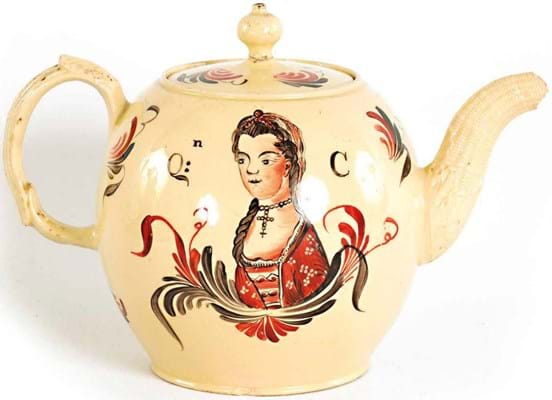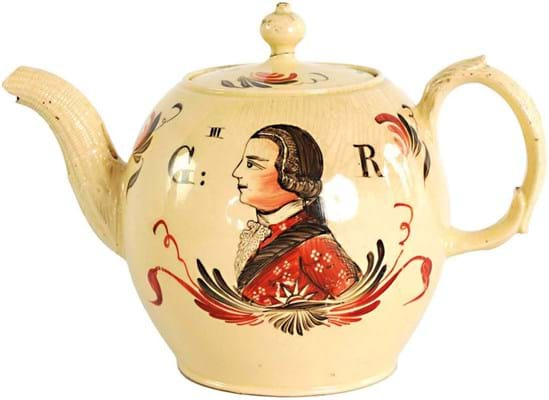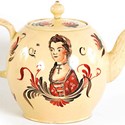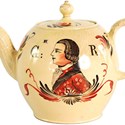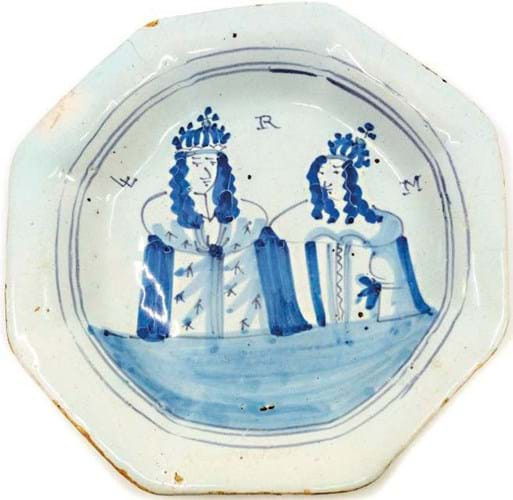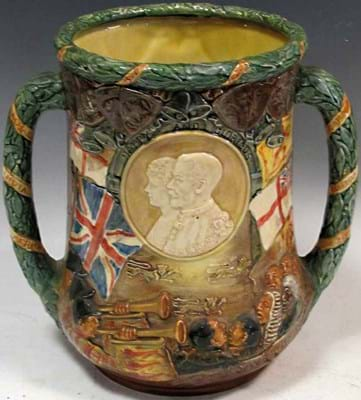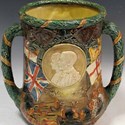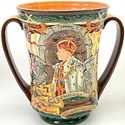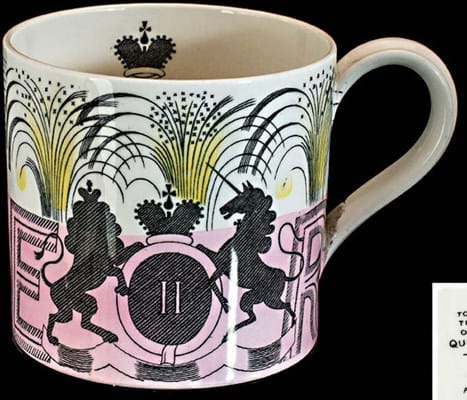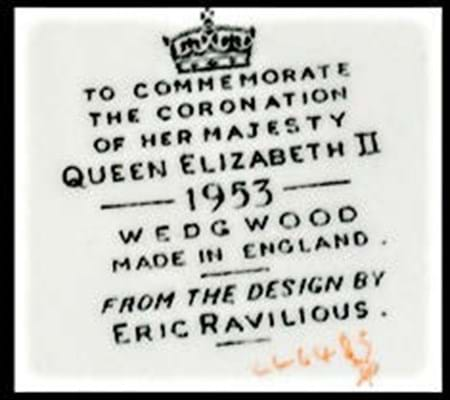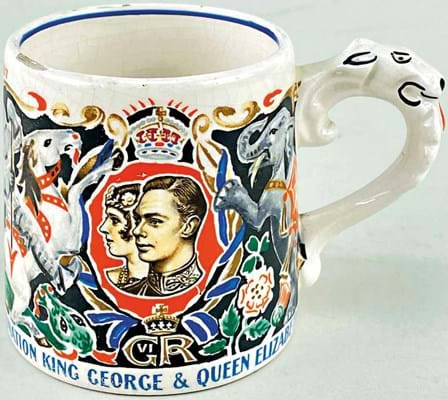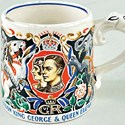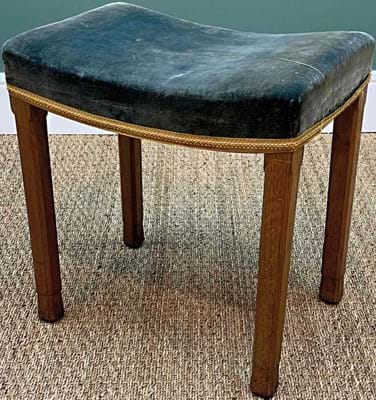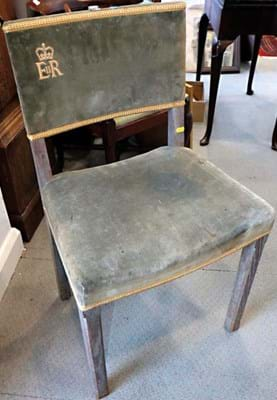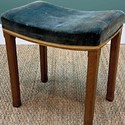English and Dutch delft plates decorated with portraits of Stuart and Hanoverian monarchs are a reminder that British coronation ceramics are a far from recent phenomenon.
They are equally admired by collectors of both early pottery and commemoratives.
If you do feel sufficiently reverential to mark 2022 with a major purchase, these rare survivors do present the ideal opportunity. At Hansons (25% buyer’s premium) in Etwall, Derbyshire, on April 1 a William and Mary English delft dish, probably London, sold for £3600 (estimate £2000-3000).
Showing a double portrait of William III (William wearing coronation robes) and Mary II, c.1689-94, between the initials WMR, within concentric circles, the 7½in (19.5cm) dish was painted in blue.
Almost every subsequent coronation, birth, death or milestone was marked in pottery and porcelain. The second half of the 18th century is a particular rich period for collecting.
Royal-tea
A good example was offered for sale in the Hutchinson Scott (25% buyer’s premium) auction in Skipton on May 26, a 4in (10cm) high Staffordshire creamware royal commemorative globular teapot, c.1770.
Probably made in Leeds, the decoration depicts bust portraits of George III and Queen Charlotte. It was not in bad condition (the spout had been chipped off and the finial glued back on) and against a guide of £400-600, sold at £3200.
The Staffordshire pottery commemorative mug became almost ubiquitous by the end of Victoria’s reign (huge numbers survive from the 1887 jubilee) but examples from 1838, the first year of the second-longest reigning British monarch, are harder to come by.
Even a damaged example can bring over £200: the fine mug by Read and Clementson printed in puce with portraits of Victoria and the Duchess of Kent took £750 as part of the Robin Simpson collection of commemoratives sold by Historical & Collectable in association with Woolley & Wallis last September.
Serious collectors can be sniffy about the mediocre quality of later mass-produced memorabilia. As supply far outstrips demand, most late 19th and 20th century pieces have little value. Even the more deluxe productions by well-known factories are quite affordable.
Sold for a within-estimate £140 at Cambridge auction house Cheffins (24.5% buyer’s premium) on May 12 was a limited-edition two-handled loving cup designed by Charles Noke and Harry Fenton for Royal Doulton to mark the silver jubilee of King George V and Queen Mary. It stands 10in (26cm) high, is moulded in low relief with figures and Windsor Castle, marked No 639/1000 and signed Noke.
A similar Noke and Fenton loving cup for Edward VIII in 1936 (the coronation that never happened) numbered 667 of 2000, (26cm) high, took a low-estimate £100 at David Duggleby (20% buyer’s premium) in Scarborough in May last year.
More to current taste are the transfer-printed ceramic designs of artist Eric Ravilious (1903-42).
Among Ravilious’ creations for Wedgwood were a mug for Edward VIII in 1936, another for George VI and Queen Elizabeth in 1937 and one adapted for Queen Elizabeth II in 1953. They have a steady following from Ravilious’ many admirers.
A 1953 mug made £220 at Welsh saleroom Rogers Jones (20% buyer’s premium) on April 8, with another selling for a high-estimate £150 at Lytham St Annes saleroom Gerrards (18% buyer’s premium) on April 14.
Laura Knight also designed a 1937 coronation mug (again, after a first attempt for King Edward VIII), although her version is much easier to find.
According to Michael Johnson of the Dame Laura Knight Society, “perhaps the most popular designs on sale” before the abdication announcement were by her for both the Burleigh and Myott companies. In her design, she seemed to have steered away from convention, whereby instead of being surrounded by the more traditional images of royalty she “introduces both a circus elephant and the George and Dragon motif alongside her portrait of Edward”. There are usually several on eBay, with one also offered at Rogers Jones that sold on low estimate for £30.
Richard Guyatt (1914-2007), who designed some of the famous You Can Be Sure Of Shell advertising posters, also created a Wedgwood mug for the 1953 coronation and a series of other royal creations stretching into the 1980s. Again these are generally very affordable.
A set of five mugs for the coronation in 1953, Prince Charles’ investiture 1969, Queen Elizabeth II and Prince Philip 25th wedding anniversary 1972, silver jubilee 1977 and Prince of Wales and Lady Diana Spencer’s wedding 1981 were sold together at Cotswold Auction Company (22% buyer’s premium) for a within-estimate £45 on April 5.
Seats of power
Furniture made specifically for coronation or investiture guests commands a steady demand at generally modest price levels.
Chairs were intended for the most eminent guests (peers) and the rest (pages) had stools. In 1902, at the coronation of Edward VII, guests were invited to buy these to keep as souvenirs and tradition began.
In 1953 the Earl of Munster discussed the matter in the House of Lords: “It may not be possible to offer more than one chair or stool to each applicant. In considering applications for chairs, preference will be given to those who occupied them. Chairs will cost £7 10s. 0d. each and stools £4 7s. 6d. each, including packing and delivery. Applications should be sent, not later than June 30, 1953, to The Controller of Supplies, Ministry of Works, Great Westminster House, Horseferry Road, London, S.W.1. The envelope should be marked ‘Abbey furniture’.”
He also noted: “Applications may also be made for the purchase of carpets and damask frontals. Preference will be given to applications from churches.”
Also at Rogers Jones, but this time on April 29, a 1953 coronation stool with original velvet upholstery, frame stamped West Wycombe 1953, and showing a crowned cypher, doubled the top estimate at £160. A 1953 chair sold for a mid-estimate £300.
Jones & Jacob (18% buyer’s premium) of Watlington, Oxfordshire, took £360, just below estimate, for a 1953 coronation limed oak and velvet chair, by W Hands & Sons Ltd, No 214.
A pair of George VI limed oak stools, one stamped GR VI Coronation, B North & Son, West Wycombe, the other GR VI Coronation, sold for £360 (guide £100-150) at Lawrences (25% buyer’s premium) of Crewkerne on April 6.
Chairs from earlier coronations will make more, especially when the guest who used them can be identified (for example, a George VI chair offered at Bonhams in 2018 together with the admittance card of the 5th Countess of Lucan to the coronation realised £1750).



